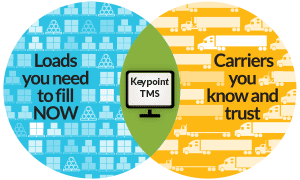 Most brokerages save a lot of time and money when they implement a TMS.
Most brokerages save a lot of time and money when they implement a TMS.
But over the years, I’ve found that brokers aren’t always aware of all the functionality they’ve purchased. And that means they miss out on critical features that could make a dramatic difference to their business.
Before I tell you about the one capability I think is most valuable, let me explain why brokers can miss key functions:
- Most brokers are trained by the person they replace. And the brokers who are leaving train newcomers only on the functions they use all the time. As this process repeats, large gaps can appear in the functionality that new brokers learn about.
- When a brokerage buys a fully featured system, it’s hard to implement everything at once. Brokerages often assume they’ll put the basic functions into effect and swing back later for other features. The problem? They never swing back.
That’s why it may turn out that the critical piece of functionality you would love to have—that will improve efficiency and profitability—is already in the TMS you own.
So what’s the most critical function that I find brokers don’t know they already have in Keypoint?
Internal freight matching for loads and trucks—the ability to enter a load and find a truck among available carriers already entered in your system.
As every broker knows, every second counts in this business. When you get a load from a customer, speed is crucial as you try to cover it before someone else does.
You certainly can access load boards to find a truck. But as good as carrier vetting programs are, you always take a risk when you bring on someone new.
That’s why it’s better to find a carrier through internal freight matching. It’s like having your own private load board with only shippers and carriers you already know and trust.
To make it work, all you have to do is enter available trucks on the Equipment Entry/Order Search screen (instead of just scribbling the information on a yellow tablet).
That will give you a number of competitive advantages:
- When you enter available trucks into Keypoint, the TMS automatically searches for and returns available loads in the vicinity.
- Everyone using your brokerage’s TMS also has access to all the truck availability information you input to cover their loads.
- If the carrier hasn’t posted the trucks on a board, you know about equipment availability that other brokerages don’t.
- Your TMS keeps a permanent history of who works which lane and how often—so the truck will be in your system the next time you run a search.
Just learning about a single function like this can make an annual training session with your TMS provider worthwhile.
If you’d like more detail on all the functions Keypoint provides, visit our website.
For more information, contact Steve Blair at Steve.Blair@dat.com.

